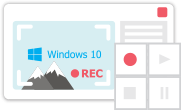Editor video
Use editor de video gratuito con la interfaz en español para crear y editar vídeos de cualquier complejidad desde una tarjeta para la familia hasta una presentación de empresa. Corte, una vídeo, aplique efectos visuales y de audio, corrección de imagen, haga diapositivas y añada una banda sonora. Utilice Croma Key multicolor y ajustes de los parámetros avanzados para dar su vídeo un aspecto profesional. Todos los formatos más populares son soportados.
Convertidor video
Convierta archivos de vídeo de un formato a otro. Todos los formatos de vídeo más populares son soportados - AVI, MOV, QT, MP4, M4V, MPEG, WMV, FLV, MKV, RealVideo (RM y RMVB), 3GP y 3G2. Haga su video disponible para la reproducción en cualquier dispositivo.
Convertidor audio
Convierta archivos de audio de un formato a otro. Todos los formatos y codecs de audio principales soportados. Gestione listas de reproducción y etiquetas meta, extraiga el audio de archivos de vídeo y guarde estas pistas en su dispositivo en cualquier formato.
Grabador de CD audio
Coja pistas de audio de discos compactos y guárdelos en cualquier formato. Todos los formatos y codecs de audio más populares son soportados. Extraiga detalles de la pista desde el servidor FreeDB para el cambio de nombre de archivo automático y actualización de las etiquetas meta.
Editor video
Convertidor video
Convertidor audio
Grabador de CD audio

Multifuncionalidad
Amplia gama de herramientas de procesamiento multimedia en un solo paquete de software de vídeo gratuito.

Alta velocidad
Nuestros programas usan algoritmos de alta calidad optimizados para las CPUs de un solo núcleo y núcleos múltiples.

Disponibilidad
VSDC está disponible gratis para la descarga a PC y portátiles con sistema operativo de Windows.
- Esta temporada navideña marca nuevos comienzos con la última actualización de VS...
- El cambio se trata de mejorar, y este proceso no sería posible sin vuestra aport...
- Introducción En 2024, la gama de opciones para crear efectos visuales es incre...
- VSDC 9.2 ya está aquí y ofrece funciones revolucionarias como la nueva herramien...
Duplicate object
Understanding and applying the Duplicate object
In VSDC video editor, you can easily create multiple copies of an object or several objects at once by using the Duplicate option. To access this feature, simply navigate to the Add Object menu located at the top of the scene area, or find it in the left side toolbar of the scene.
After selecting the Duplicate option, a pop-up window will promptly appear on your screen, providing you with the flexibility to adjust its position settings as per your preference. In this window, you can set the precise time at which the duplicate will appear on the scene, as well as how long it will remain visible before disappearing. Once you have set these parameters, click OK to apply the changes and close the window.
As soon as you select the settings, you'll notice that your cursor transforms into a crosshair, which is a crucial visual cue to help you pinpoint the precise location of the duplicated object on your screen. All you need to do is click on the desired point in the scene and drag it to specify the size and shape of the duplicate object. Once you have done this, you will see an empty object appear in both the preview window and on the timeline. This object serves as a template for your future copy, which you can easily modify and edit as needed.
Duplicate object settings
Similar to other objects in VSDC, the Duplicate object contains two groups of settings in the properties window: Common settings and Duplicate object settings.
The Common settings group provides you with the ability to modify the object's name, position in the timeline, and location in the scene. This can be extremely useful if you want to make adjustments to the settings you initially set when creating the Duplicate object.
The Duplicate object settings provide advanced options for modifying the Duplicate object to meet your specific needs.
Under the Source type option, you can define how your object or objects will be copied. For instance, selecting the Object's image duplicate option will duplicate the object in its original form. This means that any effects, color changes, or size adjustments applied to the original object will not be reflected in the duplicate. To achieve this, simply position the cursor on the part of the object you wish to copy, place the Duplicate object on the layer above, select the first option under the Source type field, and choose the desired file to copy in the Duplicated object field.
On the other hand, if you want to duplicate the object along with all the modifications that you made, including the applied effects, you need to select the second option Object duplicate, in the Source type field. Unlike the first option, this duplicate object can be positioned anywhere on any layer of the timeline, giving you more flexibility and control over its placement and appearance.
The third option in the Source type menu is called Scene Duplicate. As the name suggests, this option duplicates the entire scene that you select in the Duplicated object field. This feature can be incredibly helpful if you have a project with multiple scenes and you want to display a portion of one scene within another.
The Stretch image option indicates whether the image should be stretched to fit the size of the Duplicate object, even if it causes some cropping of the edges due to resolution differences. However, stretching the image may compromise its original aspect ratio and reduce its quality. To avoid this issue, the Pro version of the program provides advanced resizing modes, such as Nearest neighbor interpolation, Cubic Interpolation, Supersampling interpolation, and Lanczos interpolation, to help you improve the quality of your resized images.
The Fill background checkbox determines whether the background should be filled with a color or not. If selected, you can choose the color to fill the background using the Color option.
This software can be downloaded from Free Video Editor description page.

This program allows you to capture the video of your desktop and save it on your PC in various formats. Coupled with a video editor, the program is a great tool for creating presentations, tutorials and demo videos.

El programa de captura de vídeo desde dispositivos externos. Puede guardar vídeo desde sintonizadores de vídeo, cámaras web, tarjetas de captura y otros aparatos.

"VSDC Free Video Editor is a surprisingly powerful, if unconventional video editor"
- PC Advisor

"This video editor gives you tons of control and editing power"
- CNet

"The editor handles many common formats and boasts a good deal of capabilities when it comes time to alter lighting, splice video, and apply filters and transitions in post production"
- Digital Trends